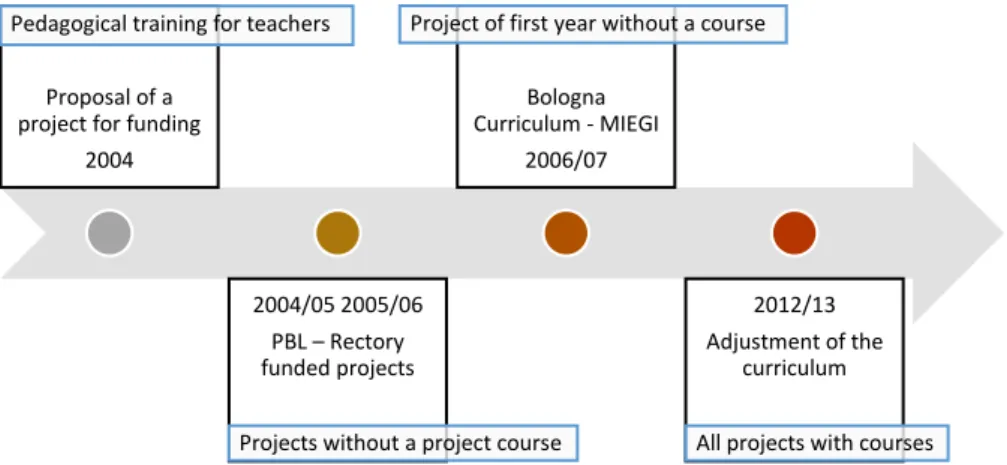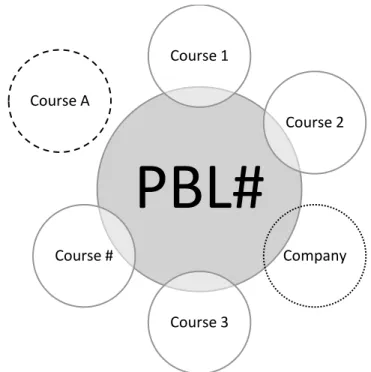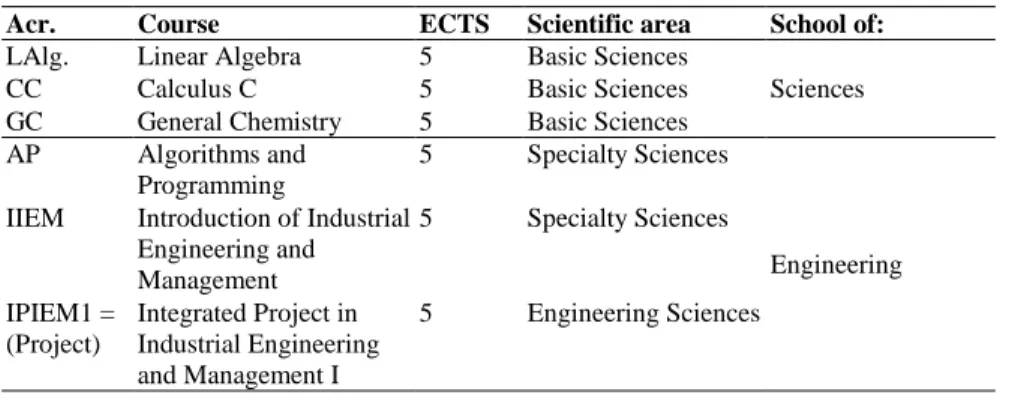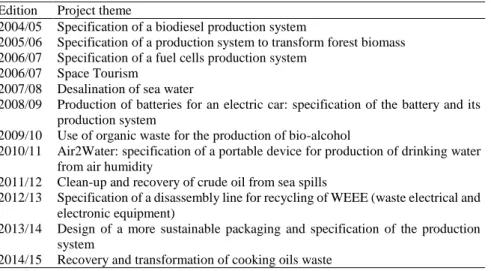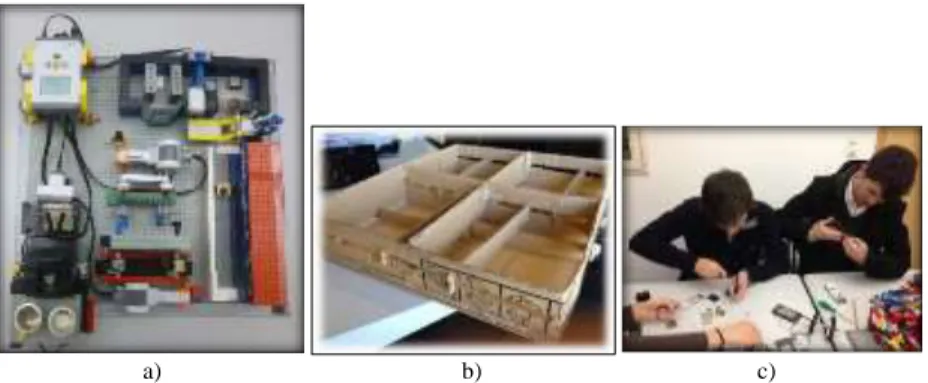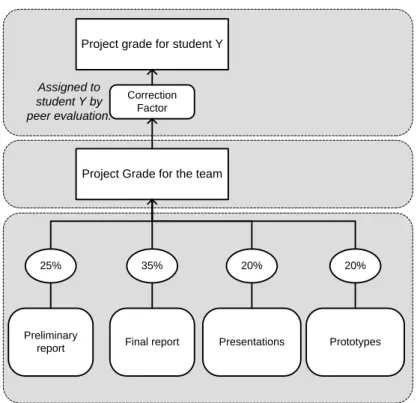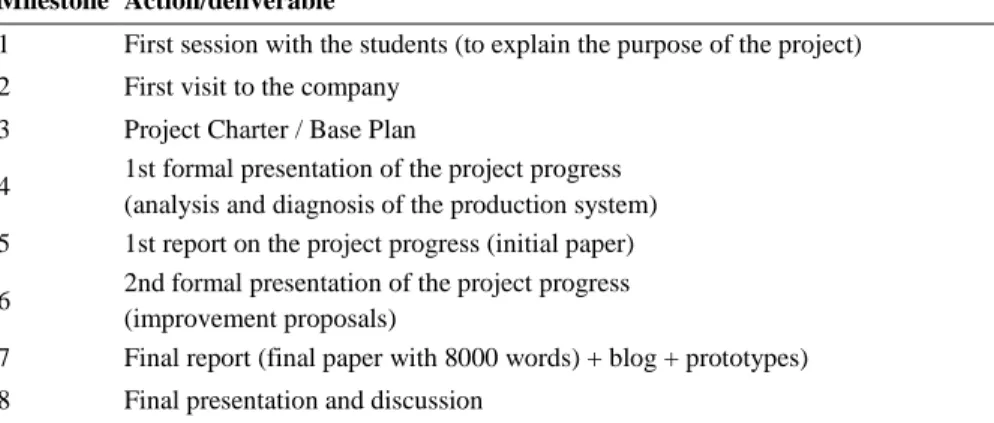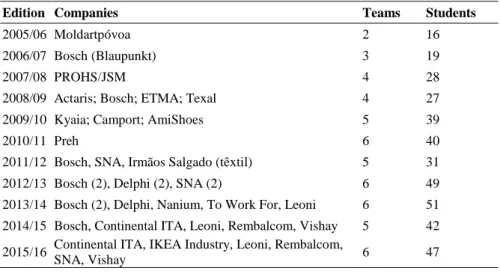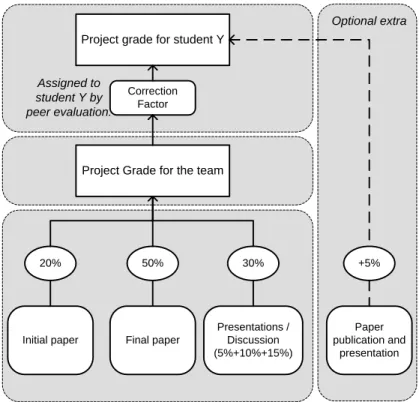ANABELA C. ALVES, FRANCISCO MOREIRA, SANDRA
FERNANDES, DIANA MESQUITA
TEN YEARS OF PROJECT-BASED LEARNING (PBL) IN
INDUSTRIAL ENGINEERING AND MANAGEMENT AT
THE UNIVERSITY OF MINHO
INTRODUCTION
Higher education institutions have been responding to challenges that have led to a transformation of educational practices, particularly towards the implementation of active learning strategies, in order to create meaningful teaching and learning experiences, with increasingly more autonomous, cooperative and motivated students. In the particular case of Engineering, graduates should be able to develop their professional activities, dealing with a wide range of different types of problems that require the proficiency of technical and transversal competences. Transversal competences are being recognized as equally relevant for the engineering practice, such as working with multicultural teams, communicating at different contexts, dealing with uncertain and unpredictable situations (Cai, 2013; Jackson, 2012; Lima, Mesquita, & Rocha, 2013; Passow, 2012). Aiming to increase the relevance of the teaching and learning processes, the Integrated Masters degree in Industrial Engineering and Management (MIEGI – acronym in Portuguese), an engineering program of 5 years (10 semesters), at the School of Engineering in the University of Minho, Portugal, focused their efforts on building curriculum innovation. The work developed was focused mainly on changing the teaching and learning processes to implement Interdisciplinary Projects (PBL - "Project based Learning"), inspired on the Powell and Weenk approach - PLEE, "Project Led Engineering Education" (Powell, 2004; Powell & Weenk, 2003). Thus, the first curriculum innovation experiences were based on Interdisciplinary Projects which started in the context of the preparation for changes within the Bologna Process demands. Currently interdisciplinary projects are part of the formal curriculum of the MIEGI.
The increasing awareness of a different professional profile needed for Industrial Engineering and Management (IEM) graduates, requiring the development of competences, both technical and transversal, and simultaneously the ambition to have students more motivated and engaged with a meaningful learning environment, were the main reasons that led a group of teachers of the IEM program at the University of Minho to start a journey of active learning amongst their courses.
Therefore, from 2005 onwards, interdisciplinary projects were developed within the MIEGI program to promote the development of technical and transversal competences (also known as professional or transferable competences), engaging student teams throughout the semester in the search of a possible solution to a problem.
The purpose of this chapter is to describe the model and changing process of 10 years of Project-Based Learning in the Integrated Masters degree program of Industrial Engineering and Management (IEM) at University of Minho, Portugal. The IEM program has three formal PBL approaches in its 10-semester curriculum, i.e. semesters 1, 7 and 8. It has some non-systematic approaches in other semesters, and a final individual master thesis project of one and a half semesters. This work will describe PBL approaches of semester 1 and 7, which were selected by their specific features, as one is a first year project (semester 1) and the other a project carried out in interaction with industrial companies (semester 7).
DRIVERS FOR CHANGE
Engineers are recognized by their technical competences and for being required to design, operate, execute, and manage technological systems. Within these processes, they must apply rigorous mathematical and scientific concepts, and tools to identify, formulate and solve problems that contribute for the society. Furthermore, but less recognized, engineers must have a strong sense of human interaction, both when designing solutions for the society and when planning, executing and managing the development of solutions.
The Bologna Process was an institutional movement all over the European Union (EU) that committed a large number of countries to change their Higher Education (HE) systems based on three main principles: quality, mobility and employability. These principles were the main drivers of improvement of HE systems, mainly concerning curriculum development and innovation. This included, for instance, the reorganization of the programs based on the uniformity of HE systems through credits system (ECTS – European Credit Transfer System) with impact on student learning, teaching practice, institutional support, amongst other issues. These were great challenges for HE institutions, followed by tensions and critical issues that needed to be explored deeper (Wihlborg & Teelken, 2014).
All countries in the EU had different timings and Portugal was committed to change in 2007 integrating the first group, including the University of Minho. Thus, in 2004, considering this national and European requirement, the rectory of the University of Minho developed a set of strategies for the implementation of curriculum changes. Within these strategies, there were opportunities for discussions, pedagogical training for teachers, and a funding program for innovative educational experiences. These experiences were developed during the period before the formal Bologna curriculum change and best practices were to be included in new curricula.
CHANGE PROCESS
All these circumstances created the appropriate groundwork for curriculum innovation by groups of teachers. The previously referred group of teachers from the IEM program involved themselves in the training opportunities provided for engineering teachers in the context of Bologna Process. Some relevant examples of the training sessions for curriculum innovation included: Richard Felder and Rebeca Brent on Active Learning; Peter Powell in Project Led Engineering Education; Manuel Firmino Torres in Effective Communication for Teachers; Maria Assunção Flores in Assessment Processes; Natascha van Hattum-Janssen in Course Planning and Peer Evaluation. All these opportunities contributed to change or reinforce teachers’ engagement with the process and the need to change the learning processes. Of great importance for the IEM program was the opportunity to learn the principles of Project-Led Engineering Education with Professor Peter Powell (Powell, 2004; Powell & Weenk, 2003). This contact provided the necessary elements to support previous ideas and experiences with project approaches in the context of engineering education. Two of these teachers were at the time teaching first year courses and decided, with the support of the program coordinator and a colleague from another department, to create a project proposal for an educational program funded by the rectory . They strongly believed that it was possible to create projects with open problems for students of the first year and that was seen as highly innovative. The project was funded by the Rectory of the University and in March 2005, the group of teachers (authors of this study) and a number of other teachers from different departments and schools of the University of Minho got together to implement a first experience of Project-Based Learning in the second semester of the first year of the IEM program. These experiences were supported, since the beginning and during the following years, by educational researchers that also integrated the coordination team and made the difference, both in regard to the implementation and evaluation process and also the research carried out in the following years.
Simultaneously with the referred first year experience, some of these teachers decided to implement a PBL experience in the last year of the IEM program, in interaction with industrial companies, and the first experience started in September 2005. Currently, the interdisciplinary projects in cooperation with industrial companies still occur and research developed in this field shows the relevance of the cooperation between university and industry (Lima, Mesquita, & Flores, 2014; Mesquita, Lima, & Flores, 2013).
The teachers and researchers involved in the first experiences aimed to develop a learning environment characterized by open-ended problems from real and meaningful contexts, in which teams of students should present solutions, by developing a wide range of technical and transversal competences. The aim was for students to mobilize their knowledge, attitudes, principles, etc., to identify, formulate and solve open-ended problems. To achieve this goal, the Project-Based Learning approach was chosen.
Figure 1 represents a timeline of the main milestones concerning the change process between 2004 and 2013. Some of these milestones have been described in the previous paragraphs, namely the funding program and the pedagogical training. Further, this timeline adds a new element: projects were implemented without a formal structure of a project course during the first editions. Additionally, even the formal curriculum created for the Bologna Process, did not include a project course in the first year. Between 2006/07 and 2012/13 the project of the first year was implemented based on an agreement between the teachers of the different courses and the program coordinator. It can be said that that this project was implemented without a formal structure in the curriculum and the program found a valid solution. Thus, despite the fact that PBL was implemented in the first semester of the year, it included formal project courses solely in the 4th year, semesters 7 and 8.
The implementation of PBL without a formal course is an important fact of the change process. At the beginning, it gave the opportunity to acquire experience, evaluate the process and prove that it is possible to innovate in the way of teaching and learning. During this process, other teachers and the institution had the opportunity to gain an increasing trust in the process and to formally allow the inclusion of PBL in the MIEGI Bologna Curriculum. Despite the fact that it was not possible to include a formal course in the first year, the results during the first years of the new curriculum and the recognition of the importance of PBL for the majority of the department, allowed the inclusion of a formal course in the first year starting in 2012/13.
Figure 1. Timeline of years 2004 to 2013
During the first years of the PBL implementation, teachers and researchers were much focused in showing that students were developing deep and rigorous technical competences, adding to transversal competences like teamwork, communication, making decisions with scarce information, formulating and solving problems. With the aim of showing these results, it was important to collect and analyse data, and
Proposal of a project for funding
2004 2004/05 2005/06 PBL – Rectory funded projects Bologna Curriculum - MIEGI 2006/07 2012/13 Adjustment of the curriculum Pedagogical training for teachers
Projects without a project course
Project of first year without a course
also start publishing about these experiences. Additionally, a PhD (Fernandes, 2011) was developed aimed at evaluating the impact of PBL on student learning and teacher’s work. Later on, another PhD (Mesquita, 2015), aimed at the definition of the IEM profile, allowed to collect data from students, teachers and professionals relating to the MIEGI and its PBL approaches. Simultaneously, the research work developed by teachers and researchers, focused on themes such as assessment processes, teamwork, project management, professional profile, teacher’s and tutor’s work, student engagement, curriculum development, university-business cooperation and operational improvement of classes.
It is possible to say that the focus on continuous improvement of the process, involving students, teachers and engineering professionals, based on an increasing support of research on engineering education, created an environment of resilient change. This resilience contributed to an ongoing history of the process and management of change of the (more than) 10 years of PBL of the Industrial Engineering and Management program at the School of Engineering at the University of Minho. This is not only a history of a group of teachers and researchers but also a history of the Department of Production and Systems and all its teachers and collaborators who trusted and believed in this process, with institutional support from the School of Engineering of the University of Minho. Ultimately, this history would not be written without persistent and innovative teachers, simultaneously supported by and supporting open-minded educational researchers and enthusiastic students.
PBL MODEL AND ELEMENTS OF CURRICULUM
The PBL model implemented in MIEGI trigger and engage students’ learning, acting as a mean for identifying the relevance of the contents in the professional practice, and increasing students’ and teachers’ motivation and application of the theory. In these projects, teams made up of 7 to 9 students integrate the courses of the semester, exploring, researching, being creative, and making decisions. The project solutions proposed by the teams are mainly based on the integration of knowledge and competencies from each course of the semesters’ study plan, thereby contributing to the development of the required learning outcomes. Technical guidance from teachers of all courses is provided to teams and further support from a teacher who plays the role of a tutor is also given. He/she contributes to support project management, teamwork, and communication. In other words, the tutor is a key-element for the development of students’ transversal competencesThe PBL of the first semester begins on the first day of class for the 1st year and intends to integrate the contents of the courses of this semester. That way it involves initial courses of engineering and basic sciences, in a project that addresses the issue of sustainability. In the implementation of PBL in semester 7, teams of students aim to develop a project in an industrial environment that, in general terms, involves two phases: (i) analysis and diagnosis of the production system of a company and (ii)
development of proposals for improvement. Dealing directly with companies and their real problems causes a strong motivation both on students and teachers. So far, nine editions of PBL were carried out in interaction with 17 companies, involving more than 35 teams of 249 students. In these contexts, longitudinal studies have been conducted based on two PhD projects identifying the positive results of this learning methodology.
The general project approach of IEM considers the integration of the semester courses and eventually, external partners (usually industrial companies), as illustrated by Figure 2. There is also the possibility of non-integration of a course if the project theme and goals do not create a good match with that course’s contents and objectives.
Figure 2. Illustration of the PBL interaction between project, courses and external partners
PBL model and curriculum elements in the first semester – Project 1
PBL implemented in the first semester, first year of the Industrial Engineering and Management program (IEM11_PBL) has been implemented since the 2004/05 academic year (Lima, Dinis-Carvalho, Flores, & Hattum-Janssen, 2007) and during a decade, 12 editions (or cohorts) were implemented, encompassing more than 520PBL#
Course 1
Course 2
Company
Course 3
Course #
Course A
students and 70 work teams. The PBL model implemented at IEM11 (IEM11_PBL) is based on the six courses of the semester, three from the School of Sciences and three from the School of Engineering (Alves et al., 2012). Table 1 presents the courses, their acronyms (Acr.), European Credits Transfer System (ECTS) of each course, scientific area and school. It should be noted that one ECTS represents 25-30 hours of student work and the IEM program is a five-year program (10 semesters) with 300 ECTS.
Table 1. Courses of the 1st year, 1st semester of the IEM program
Acr. Course ECTS Scientific area School of:
LAlg. Linear Algebra 5 Basic Sciences
Sciences CC Calculus C 5 Basic Sciences
GC General Chemistry 5 Basic Sciences AP Algorithms and
Programming
5 Specialty Sciences
Engineering IIEM Introduction of Industrial
Engineering and Management 5 Specialty Sciences IPIEM1 = (Project) Integrated Project in Industrial Engineering and Management I 5 Engineering Sciences
The learning project is developed in the context of the Integrated Project of Industrial Engineering and Management (IPIEM1) course, also called “Project”. Each teacher responsible for each course defines the content of each course that is incorporated into the Project.
The development of an integrated PBL approach from day one rests on a number of rationales, namely: to engage the students from the start on the learning process; to promote active learners and meaningful and integrated learning; to stimulate and reward the development of individual technical competences and knowledge dissemination among peers; to promote the development of teamwork skills and a number of other transversal competences. The range of technical competences, ought to be developed, as defined by a number of courses, is therefore translated into an open challenge (the project theme) that the team has to tackle, by designing developing and ultimately making a compelling argument around a product and the respective production system. The learning outcomes are defined in the project guide, which is a document prepared by the coordination team, which supports and guides the students throughout the semester. In this document students find information about the PBL methodology, the teachers’ contacts, tutor information, learning outcomes for each course unit, scheduled classes and project milestones, assessment model and physical resources (e.g. room project, lockers,…) and the e-learning platform.
The coordination team usually includes six or seven teachers related to the Project Supporting Courses (PSC) and six tutors (one or two teachers are simultaneously teachers and tutors). Educational researchers have also been involved in this team. As the members come from different schools/departments, there is always a wide diversity of ideas and experiences. The staff team does not change much from year to year, except in the case of Maths (e.g. Calculus C), which during many years changed almost in a yearly basis, but recently it seems to be stabilizing. In Alves, Sousa, Fernandes, et al. (2016), it is possible to analyse the years of experience of each teacher as well as a detailed description of the IEM11_PBL.
The project theme is usually related with sustainability issues for two main reasons: (1) to raise students awareness on this underlying dimension of human development, and (2) to be contemporary and attractive for the students (Moreira, Mesquita, & Hattum-Janssen, 2011). Table 2 presents a timeframe with the list of the 12 PBL editions implemented over the period of a decade.
Table 2. Editions and themes of a decade of PBL projects at IEM11 Edition Project theme
2004/05 Specification of a biodiesel production system
2005/06 Specification of a production system to transform forest biomass 2006/07 Specification of a fuel cells production system
2006/07 Space Tourism
2007/08 Desalination of sea water
2008/09 Production of batteries for an electric car: specification of the battery and its production system
2009/10 Use of organic waste for the production of bio-alcohol
2010/11 Air2Water: specification of a portable device for production of drinking water from air humidity
2011/12 Clean-up and recovery of crude oil from sea spills
2012/13 Specification of a disassembly line for recycling of WEEE (waste electrical and electronic equipment)
2013/14 Design of a more sustainable packaging and specification of the production system
2014/15 Recovery and transformation of cooking oils waste
The IEM11_PBL process includes five phases: (1) preparation, (2) setup, (3) start-up, (4) execution and (5) end (Lima et al., 2012). The first semester starts in September and finishes in February, corresponding to 20 weeks of activities (including the evaluation weeks). In Phase 1, prior to the start of the semester, the possible project themes are identified and the human resources involved are allocated. In Phase 2, the definition and specification of the project theme, definition of project’s schedule (including milestones) and assessment model, and, elaboration of the project’s guide (document provided to students including all the relevant information about the project) are set out. Phase 3 is marked by the start of classes, and includes a project presentation session, setting up of student teams and training (e.g. teamwork and communication skills) and, finally, the assessment of the pilot project (teams of students have one week to perform a kind of state-of-the-art
analysis on the subject of the project’s theme). In Phase 4, the students execute the process, i.e., have classes, tutorial meetings, develop prototypes (Figure 3), monitor progress and receive feedback.
a) b) c)
Figure 3. a) Production system prototype in Lego Mindstorms; b) a product prototype (cohort 2013_14); c) students disassembling a product (cohort 2012_13)
During the whole process, the IPIEM1 students are divided into six teams of about seven to nine students each. Each team has the support of a tutor. Each team must organize their tasks properly and manage their project in a formal way. Peer assessment and individual evaluation are used as mechanisms to prevent free riding, to monitor team performance and to develop team work competences. The project progress and individual competencies are monitored during the semester by assessing the project deliverables after the accomplishment of the milestones, by the PSC teachers. Findings from research show that students and teachers agree in the difficulty of assessing this learning process, however they continue engaged in their continuous improvement (Fernandes, Flores, & Lima, 2012b; Fernandes, Mesquita, Flores, & Lima, 2014). Some of the main difficulties identified by students are related to the individual assessment of each team member and the integration of contents from all courses in the project. For teachers, the main difficulties are linked to assessing student’s competences’ and providing a grade. They find that it is not a trivial process to grade the development of competences.
The main part of the summative assessment process is done during the final phase (phase 5). This process involves the calculation of the student’s final grade, taking in account: 1) assessment of the project’s final reports, oral presentations and prototypes; 2) individual written test by students and 3) peer assessment. The assessment model is represented in Figure 4. Each component has a different weight, as shown, and this model can change every year.
Project grade for student Y
Correction Factor
Project Grade for the team
Preliminary
report Final report Presentations
25% 35% 20% Assigned to student Y by peer evaluation. Prototypes 20%
Figure 4. Assessment model of PBL semester in year 2012/13.
A final workshop is also prepared in this final phase to address the concerns, difficulties and feedback of students about the PBL process through an online questionnaire and some focus groups.
Since the first year, students and teachers, supported by educational researchers, have the important goal of continuous improvement of the learning process. Difficulties are part of the process but teachers are willing to learn how to manage them (Alves, Sousa, Moreira, et al., 2016) and develop further research to improve the process and implement new ideas and suggestions from students and all stakeholders involved (Alves & Leão, 2015). For example, one of the main changes suggested by the students was the formal existence of a course called “project” to be integrated in the program and this happened in the academic year 2012/13 (Alves et al., 2014).
PBL model and curriculum elements in the seventh semester– Project 2
As previously referred in the introduction, our program is an Integrated Masters degree in Industrial Engineering and Management, an engineering program of 5 consecutive years (10 semesters). The program can receive a marginal number ofstudents in every semester by transfer processes, but the master program is not separated from the bachelor. Thus, the great majority of the students enrolled in this project had the experience of the first year project. Students who did not have that experience will have the opportunity to talk with colleagues, the tutor and the coordinator of the project to clarify any doubts. After several years of evaluation of the projects, this issue has never appeared as problem, as the new students will gain experience during the process.
The PBL model adopted for the 7th semester involves the development of a project
within industry, incorporating the knowledge and competences inherent to all the courses of the semester (Lima, Carvalho, et al., 2014; Lima, Mesquita, Dinis-Carvalho, & Sousa, 2015; Lima, Mesquita, et al., 2014). Typically, 5 to 6 teams of students are created (each one with 7 to 9 students) and each company, depending on its size, may receive 1 or 2 teams. The courses of the semester are: (i) Organization of Production Systems II (OSP2), (ii) Information Systems for Production (SIP), (iii) Production Integrated Management (GIP), (iv) Ergonomic Study of Workplaces (EEPT), (v) Simulation (SIM) and (vi) Integrated Project on Industrial Engineering and Management II (PIEGI2). The course PIEGI2 formally includes the PBL concept on the curriculum, and its grading system considers not only the developed technical competences but also transversal competences, as well as peer assessment.
Besides the support of the course teachers, each team of students has a tutor to help in the project management issues (including, when necessary, conflict management). On the first visit to the company, the tutor goes with the team (to introduce students and clarify the project’s purpose) but the subsequent visits (typically on a weekly basis) are managed by the team.
Along the years, the typology of these projects has followed a common pattern, mentioned at the beginning of this section: (i) analysis and diagnosis of the production system and (ii) development of improvement proposals. The duration of the first phase should not exceed half of the semester and the analysis and diagnosis is conducted in the context of all the courses of the semester. More specifically, the production system is subject to: (i) characterization and classification, (ii) performance evaluation, (iii) waste identification, (iv) identification of the main functions and techniques of production planning and control and how they are integrated, (v) identification of the information flow , (vi) evaluation of the adequacy of existing software regarding the functional and information requisites of the production system, and (vii) characterization of the workstations’ ergonomics and physical environment. Items (i) to (iii) are inherent to the course OSP2, (iv) and (v) to GIP, (v) and (vi) to SIP and (vii) to EEPT. Note that (v) is conducted in the context of both GIP and SIP. The contents of the course SIM (namely the simulation models) are only applied in the second phase of the project in order to explore possible alternative solutions and estimate the corresponding results.
The second phase lasts until the end of semester and the teams are expected to develop solutions for the identified problems. Eventually, a single improvement
addressing a single problem (maybe involving a single course) may be proposed, if, obviously, its relevance/impact is considered as important by all the stakeholders. The monitoring of the project progress involves several milestones (Table 3), many of them associated to some kind of deliverables (e.g. presentations, papers and eventual prototypes).
Table 3. Milestones of a typical 7th semester PBL edition.
Milestone Action/deliverable
1 First session with the students (to explain the purpose of the project) 2 First visit to the company
3 Project Charter / Base Plan
4 1st formal presentation of the project progress (analysis and diagnosis of the production system) 5 1st report on the project progress (initial paper) 6 2nd formal presentation of the project progress
(improvement proposals)
7 Final report (final paper with 8000 words) + blog + prototypes) 8 Final presentation and discussion
Since 2005/06 academic year there were 11 PBL editions. It should be noted that during the first two editions, before the curriculum change, the projects were developed in the first semester of the fifth year, involving less courses. Table 4 indicates the companies involved along with the corresponding number of teams and students. The companies are from different types of industry, namely: (i) medical equipment, (ii) metal mechanics, (iii) electronic devices for the automotive industry, (iv) textiles and clothing, (v) footwear, (vi) saws and files, (vii) semiconductors, (viii) electrical wiring for the automotive industry, (ix) packaging materials, (x) capacitors, (xi) tyres, and (xii) wood and furniture. This diversity is quite positive because different environments are addressed (each one with specific types of problems), contributing thus to a more enriching experience, not only for students but also for the teachers.
Table 4. Seventh semester PBL editions since 2005/06.
Edition Companies Teams Students
2005/06 Moldartpóvoa 2 16
2006/07 Bosch (Blaupunkt) 3 19
2007/08 PROHS/JSM 4 28
2008/09 Actaris; Bosch; ETMA; Texal 4 27 2009/10 Kyaia; Camport; AmiShoes 5 39
2010/11 Preh 6 40
2011/12 Bosch, SNA, Irmãos Salgado (têxtil) 5 31 2012/13 Bosch (2), Delphi (2), SNA (2) 6 49 2013/14 Bosch (2), Delphi, Nanium, To Work For, Leoni 6 51 2014/15 Bosch, Continental ITA, Leoni, Rembalcom, Vishay 5 42 2015/16 Continental ITA, IKEA Industry, Leoni, Rembalcom,
SNA, Vishay 6 47
An important issue in this PBL model involving industry is the definition of projects to be assigned to student teams. Two months before the beginning of the semester, the coordinator of the project, with the help of two or three teachers of the semester, starts the contacts with companies. These contacts are mainly based on the networking of the teachers and, usually, the contact is made with 6 to 8 companies. If the number of companies is smaller than the number of teams, the company will have difficulties to manage the high number of students in their facilities. Thus, having as many companies as teams makes it easy to get companies interested in receiving the teams, but increases the number of communication channels and efforts to align with all companies’ expectations. Repeating companies in consecutive years allows to make this process easier. In general, companies define their projects using two main different approaches. Approach 1 - the company leaves all the decisions to the students. Students must select a production system (area) where the project should take place and then the students also must identify problems to be analysed and possible solutions. Approach 2 – the company assigns a specific part of the production system and the problems to be addressed. Large companies tend to provide projects defined in more detail with little room for changes while smaller companies tend to leave most decisions to student teams. In any case, all projects must be previously analysed by PBL coordinators to assure the alignment to the PBL supporting courses with the objectives of the project course.
In the first phase of the project (analysis and diagnosis of the production system) all student teams tend to follow more or less the same approach. Typically teams go through the following list of possible steps:
Collect general data about the production system (type of products, type of processes, number of workers, layout …).
Build a Value Stream Map (a technical tool to identify the process steps) and identify and measure production waste.
Collect data regarding existing performance indicators and data to create important new ones.
Identify and describe the existing information systems.
Diagnose working conditions regarding ergonomics, noise and lighting conditions.
In the second phase of the projects, students must identify and select one or two improving opportunities, design the solutions and implement them. Examples of types of interventions are:
Layout changes in order to improve production flows, productivity and lead times.
Reduce setup times in machines using SMED method. Design production cells for a specific product family.
Improve the internal logistics systems (include supermarkets design, improving warehouse layouts, and “mizusumashi” systems
implementation).
Improve workstation organization to improve working conditions and performance.
Design and implement pull flow systems such as Kanban systems in order to reduce work-in-process and lead-times.
During the development of tasks of phase 1 and phase 2, students must develop the competences expected by the project supporting courses, simultaneously learning the courses’ contents by means of the problems they are solving, and applying the contents to solve those problems. The development of the courses’ competences are the base element of this PBL model. Additionally they will be developing several transversal competences because they are developing this team project, namely: team work, project management, communication in professional contexts, creativity, problem solving and making decisions with scarce information.
The assessment model adopted in the 7th semester PBL project includes a number of
elements of different types (Fernandes, Flores, & Lima, 2012a; Lima, Mesquita, Fernandes, Marinho-Araújo, & Rabelo, 2015) and is represented in Figure 5. The final grade of a student for a given course X is obtained from the individual grade achieved through continuous assessment of course X and from the individual grade of the project. The individual grade of the project is obtained by multiplying the team grade of the project by a correction factor (CF) determined by peer assessment. The team grade of the project considers the assessment of: initial paper (20%), final paper (50%) and presentations (3 presentations: 5% + 10% + 15%). If some students are able to submit and publish a paper based on their project work, a bonus of 5% is attributed to their grade.
Project grade for student Y
Correction Factor
Project Grade for the team
Initial paper Final paper
Presentations / Discussion (5%+10%+15%) Paper publication and presentation 20% 50% 30% +5% Optional extra Assigned to student Y by peer evaluation.
Figure 5. Assessment model of the 7Th semester PBL project.
FUTURE PERSPECTIVES AND VISIONS
The PBL approach implemented since 2005 is quite stable in the IEM curriculum. Nevertheless, improvements are always being implemented during the years. In semester 1, the main change was related to the introduction of a project course, which formalized the way teachers were involved and changed some assessment practices. In semester 7, several changes in the process resulted mainly from the suggestions collected from students, teachers and professionals, during the process evaluation phase, developed at the end of the semester. As an example, a change implemented a few years ago, allowed students to quit integrating some of the courses at the middle of the semester (after the problem diagnosis) in order to focus on some specific requirements of the companies.
Some of the main challenges of the PBL model, according to teachers and researchers involved, are the following:
- Maintain project workspaces available for all teams during the whole semester. This is one of the main differences of our model in comparison with other projects at the University of Minho.
- Create opportunities for continuous pedagogical training and professional development of teachers.
- Continuously strengthen teacher’s motivation for the PBL processes and, in general, introduce innovation in the learning processes.
- Create some homogeneity between the tutors’ performance and practices. - Keep the continuous interest of companies in the students’ projects. - Develop increased focus in projects that involve companies,
simultaneously satisfying the students, teachers and professionals’ expectations.
- Improve the interdisciplinary approaches between different knowledge areas.
- Improve the project management approaches by the teams of students and by the coordination team.
- Improve and/or develop new models for the assessment of competences. - Increase the recognition of engineering education research among the
engineering community, simultaneously by its impact on the education of engineers and its impact on engineering fields.
There are common visions between the teachers and researchers involved in PBL at IEM program at the School of Engineering of the University of Minho and the main one is that it is always possible to improve the process and the results. The staff involved are continuously putting efforts to create the best opportunities for the development of students’ competences. This vision is centered on the motivation to engage students in processes that allow them to trial and fail, to learn with mediation, to develop rigorous technical competences with commitment, effort and fun. In this way, the PBL process aims to keep reducing the gap between the developed competences and the required competences for the professional practice and for the needs of the society.
The experience of PBL in the IEM program has shown evidence of the benefits of this approach at different levels and that there is still much more that can be done: is: there should be opportunities for more projects in the curriculum, more projects in interaction with companies and with the society, more projects in interaction with other cultures and students from other programs, increased interaction with staff from other departments, engineering education research recognized by peers, and more opportunities for staff development. In summary, a sustainable world needs learner-centered systems to be in the backpacks of engineering educators and researchers, and problem and project-based learning principles can be the baseline for such systems.
AKNOWLEDGMENTS
The authors would like to thank all students of the IEM program since 2004/05 for their contributions and enthusiastic cooperation. Thanks to the Department of
Production and Systems, the School of Engineering and the University of Minho for all their support. Thanks to all teachers from different departments that have been working in these PBL approaches. A movement of change like this is possible with people that believe and do things during the process that allow reflecting, improving and building up great things. Some of these persons are students, some were in the rectory team creating opportunities for change and others were operationally changing tables and chairs from place to place. Thank you all.
This work was partially funded by COMPETE-POCI-01-0145-FEDER-007043 and FCT-UID-CEC-00319-2013.
REFERENCES
Alves, A., & Leão, C. P. (2015). Action, practice and research in Project-Based
Learning in an Industrial Engineering and Management program. Paper
presented at the Proceedings of the ASME 2015 International Mechanical Engineering Congress & Exposition (IMECE2015).
Alves, A., Moreira, F., Lima, R. M., Sousa, R. M., Dinis-Carvalho, J., Mesquita, D., . . . Hattum-Janssen, N. v. (2012, 9-15 november, 2012). Project Based
Learning in first year, first semester of Industrial Engineering and Management: some results. Paper presented at the IMECE 2012 - ASME
International Mechanical Engineering Congress & Exposition, Houston, EUA.
Alves, A., Sousa, R., Moreira, F., Carvalho, M. A., Cardoso, E., Pimenta, P., . . . Mesquita, D. (2016). Managing PBL Difficulties in an Industrial Engineering and Management Program. Journal of Industrial Engineering
and Management, 9(3), 73-89. doi: http://dx.doi.org/10.3926/jiem.1816
Alves, A., Sousa, R. M., Fernandes, S., Cardoso, E., Carvalho, M. A., Figueiredo, J., & Pereira, R. M. S. (2016). Teacher's experiences in PBL: implications for practice. European Journal of Engineering Education, 41(2), 123-141. doi: 10.1080/03043797.2015.1023782
Cai, Y. (2013). Graduate employability: a conceptual framework for understanding employers’ perceptions. Higher Education, 65, 457–469. doi: 10.1007/s10734-012-9556-x
Fernandes, S. (2011). Aprendizagem baseada em Projectos no Contexto do Ensino
Superior: Avaliação de um dispositivo pedagógico no Ensino de Engenharia. (Doutoramento), Universidade do Minho, Braga, Portugal.
Fernandes, S., Flores, M. A., & Lima, R. M. (2012a). Student Assessment in Project Based Learning. In L. C. d. Campos, E. A. T. Dirani, A. L. Manrique & N. v. Hattum-Janssen (Eds.), Project Approaches to Learning in Engineering
Education: The Practice of Teamwork (pp. 147-160). Rotterdam, The
Netherlands: SENSE.
Fernandes, S., Flores, M. A., & Lima, R. M. (2012b). Student’s views of assessment in project-led engineering education: findings from a case study in Portugal.
Fernandes, S., Mesquita, D., Flores, M. A., & Lima, R. M. (2014). Engaging students in learning: findings from a study of project-led education. European
Journal of Engineering Education, 39(1), 55-67. doi:
10.1080/03043797.2013.833170
Jackson, D. (2012). Testing a model of undergraduate competence in employability skills and its implications for stakeholders. Journal of Education and Work. doi: 10.1080/13639080.2012.718750
Lima, R. M., Carvalho, D., Sousa, R. M., Alves, A., Moreira, F., Mesquita, D., & Fernandes, S. (2012). A Project Management Framework for Planning and Executing Interdisciplinary Learning Projects In Engineering Education. In L. C. d. Campos, E. A. T. Dirani, A. L. Manrique & N. v. Hattum-Janssen (Eds.), Project Approaches to Learning in Engineering Education: The
Practice of Teamwork (pp. 53-76). Rotterdam, The Netherlands: SENSE.
Lima, R. M., Dinis-Carvalho, J., Campos, L. C. d., Mesquita, D., Sousa, R. M., & Alves, A. (2014, 28-29 July 2014). Projects with the Industry for the
Development of Professional Competences in Industrial Engineering and Management. Paper presented at the Sixth International Symposium on
Project Approaches in Engineering Education (PAEE'2014), Medellin, Colombia.
Lima, R. M., Dinis-Carvalho, J., Flores, M. A., & Hattum-Janssen, N. v. (2007). A case study on project led education in engineering: students' and teachers' perceptions. European Journal of Engineering Education, 32(3), 337 - 347. Lima, R. M., Mesquita, D., Dinis-Carvalho, J., & Sousa, R. M. (2015, 6-9 July 2015).
Promoting the Interaction with the Industry through Project-Based Learning. Paper presented at the Seventh International Symposium on
Project Approaches in Engineering Education (PAEE'2015), part of International Joint Conference on the Learner in Engineering Education (IJCLEE 2015), San Sebastian, Spain.
Lima, R. M., Mesquita, D., Fernandes, S., Marinho-Araújo, C., & Rabelo, M. L. (2015, 6-9 July 2015). Modelling the Assessment of Transversal
Competences in Project Based Learning. Paper presented at the Fifth
International Research Symposium on PBL, part of International Joint Conference on the Learner in Engineering Education (IJCLEE 2015), San Sebastian, Spain.
Lima, R. M., Mesquita, D., & Flores, M. A. (2014, 31/05/2014 - 03/06/2014).
Project Approaches in Interaction with Industry for the Development of Professional Competences. Paper presented at the Industrial and Systems
Engineering Research Conference (ISERC 2014), Montréal, Canada. Lima, R. M., Mesquita, D., & Rocha, C. (2013, 2013-07-31). Professionals’
Demands for Production Engineering: Analysing Areas of Professional Practice and Transversal Competences. Paper presented at the
International Conference on Production Research (ICPR 22), Foz do Iguassu, Brazil.
Mesquita, D. (2015). O Currículo da Formação em Engenharia no âmbito do
Profissional e Empregabilidade na Perspetiva dos Docentes, dos Estudantes e dos Empregadores. (Doutoramento em Ciências da Educação,
Especialidade em Desenvolvimento Curricular), Universidade do Minho, Braga, Portugal.
Mesquita, D., Lima, R. M., & Flores, M. A. (2013, 8-9 July 2013). Developing
professional competencies through projects in interaction with companies: A study in Industrial Engineering and Management Master Degree. Paper
presented at the Fifth International Symposium on Project Approaches in Engineering Education (PAEE'2013): Closing the Gap between University and Industry, Eindhoven, The Netherlands.
Moreira, F., Mesquita, D., & Hattum-Janssen, N. v. (2011, 01-02 October 2011). The
importance of the project theme in Project-Based Learning: a study of student and teacher perceptions. Paper presented at the International
Symposium on Project Approaches in Engineering Education (PAEE’2011): Aligning Engineering Education with Engineering Challenges, Lisbon - Portugal.
Passow, H. J. (2012). Which ABET Competencies Do Engineering Graduates Find Most Important in their Work? Journal of Engineering Education, 101(1), 95–118.
Powell, P. C. (2004). Assessment of team-based projects in project-led education.
European Journal of Engineering Education, 29(2), 221-230.
Powell, P. C., & Weenk, W. (2003). Project-Led Engineering Education. Utrecht: Lemma.
Wihlborg, M., & Teelken, C. (2014). Striving for Uniformity, Hoping for Innovation and Diversification: a critical review concerning the Bologna Process - providing an overview and reflecting on the criticism. Policy Futures in
Education, 12(8), 1084-1100.
AFFILIATIONS
Rui M. Lima, José Dinis-Carvalho, Rui M. Sousa, Anabela C. Alves, Francisco Moreira
Department of Production and Systems and ALGORITMI Research Centre, School of Engineering of University of Minho, Portugal
Sandra Fernandes
Diana Mesquita
